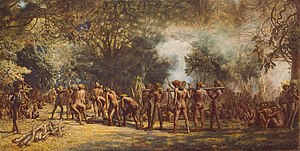
Human cannibalism is the act or practice of humans eating the flesh or internal organs of other human beings. A person who practices cannibalism is called a cannibal. The meaning of "cannibalism" has been extended into zoology to describe animals consuming parts of individuals of the same species as food.
Anatomically modern humans, Neanderthals, and Homo antecessor are known to have practised cannibalism to some extent in the Pleistocene.[1][2][3][4][5] Cannibalism was occasionally practised in Egypt during ancient and Roman times, as well as later during severe famines.[6][7] The Island Caribs of the Lesser Antilles, whose name is the origin of the word cannibal, acquired a long-standing reputation as eaters of human flesh, reconfirmed when their legends were recorded in the 17th century.[8] Some controversy exists over the accuracy of these legends and the prevalence of actual cannibalism in the culture.
Cannibalism has been well documented in much of the world, including Fiji (once nicknamed the "Cannibal Isles"),[9] the Amazon Basin, the Congo, and the Māori people of New Zealand.[10] Cannibalism was also practised in New Guinea and in parts of the Solomon Islands, and human flesh was sold at markets in some parts of Melanesia[11] and of the Congo Basin.[12][13] A form of cannibalism popular in early modern Europe was the consumption of body parts or blood for medical purposes. Reaching its height during the 17th century, this practice continued in some cases into the second half of the 19th century.[14]
Cannibalism has occasionally been practised as a last resort by people suffering from famine. Well-known examples include the ill-fated Donner Party (1846–1847), the Holodomor (1932–1933), and the crash of Uruguayan Air Force Flight 571 (1972), after which the survivors ate the bodies of the dead. Additionally, there are cases of people engaging in cannibalism for sexual pleasure, such as Albert Fish, Issei Sagawa, Jeffrey Dahmer, and Armin Meiwes. Cannibalism has been both practised and fiercely condemned in several recent wars, especially in Liberia[15] and the Democratic Republic of the Congo.[16] It was still practised in Papua New Guinea as of 2012, for cultural reasons.[17][18]
Cannibalism has been said to test the bounds of cultural relativism because it challenges anthropologists "to define what is or is not beyond the pale of acceptable human behavior".[19] A few scholars argue that no firm evidence exists that cannibalism has ever been a socially acceptable practice anywhere in the world,[20] but such views have been largely rejected as irreconcilable with the actual evidence.[21][22]
- ^ Culotta, E. (October 1, 1999). "Neanderthals Were Cannibals, Bones Show". Science. 286 (5437). Sciencemag.org: 18b–19. doi:10.1126/science.286.5437.18b. ISSN 0036-8075. PMID 10532879. S2CID 5696570.
- ^ Gibbons, A. (August 1, 1997). "Archaeologists Rediscover Cannibals". Science. 277 (5326). Sciencemag.org: 635–637. doi:10.1126/science.277.5326.635. PMID 9254427. S2CID 38802004.
- ^ Rougier, Hélène; Crevecoeur, Isabelle; Beauval, Cédric; Posth, Cosimo; Flas, Damien; Wißing, Christoph; Furtwängler, Anja; Germonpré, Mietje; Gómez-Olivencia, Asier; Semal, Patrick; van der Plicht, Johannes; Bocherens, Hervé; Krause, Johannes (July 6, 2016). "Neandertal cannibalism and Neandertal bones used as tools in Northern Europe". Scientific Reports. 6 (1): 29005. Bibcode:2016NatSR...629005R. doi:10.1038/srep29005. ISSN 2045-2322. PMC 4933918. PMID 27381450.
- ^ Davis, Josh (October 4, 2023). "Oldest evidence of human cannibalism as a funerary practice". Natural History Museum – Science News. Retrieved February 26, 2024.
- ^ Carbonell, Eudald; Cáceres, Isabel; Lozano, Marina; Saladié, Palmira; Rosell, Jordi; Lorenzo, Carlos; Vallverdú, Josep; Huguet, Rosa; Canals, Antoni; Bermúdez de Castro, José Marı́a (2010). "Cultural Cannibalism as a Paleoeconomic System in the European Lower Pleistocene". Current Anthropology. 51 (4): 543. doi:10.1086/653807. JSTOR 10.1086/653807. S2CID 1311044.
- ^ Thompson, Jason (2008). A History of Egypt: From Earliest Times to the Present. American University in Cairo Press. ISBN 978-977-416-091-2.
- ^ Tannahill 1975, pp. 47–55.
- ^ Myers, Rovert A. (1984). "Island Carib Cannibalism". Nieuwe West-Indische Gids / New West Indian Guide. 58 (3/4): 147–184. ISSN 0028-9930. JSTOR 41849170.
- ^ Sanday, Peggy Reeves (1986). Divine Hunger: Cannibalism as a Cultural System. Cambridge, UK: Cambridge University Press. p. 151. ISBN 978-0-521-31114-4.
- ^ Rubinstein 2014, pp. 17–18.
- ^ Knauft 1999, p. 104.
- ^ Edgerton 2002, p. 109.
- ^ Siefkes 2022, pp. 118–121.
- ^ Sugg, Richard (2015). Mummies, Cannibals and Vampires: The History of Corpse Medicine from the Renaissance to the Victorians. Routledge. pp. 122–125 and passim.
- ^ Schmall, Emily (August 1, 2011). "Liberia's elections, ritual killings and cannibalism". GlobalPost. Retrieved November 22, 2023.
- ^ "UN Condemns DR Congo Cannibalism". BBC. January 15, 2003. Retrieved October 29, 2011.
- ^ "Cannibal Cult Members Arrested in PNG". The New Zealand Herald. July 5, 2012. ISSN 1170-0777. Retrieved November 28, 2015.
- ^ Raffaele, Paul (September 2006). "Sleeping with Cannibals". Smithsonian Magazine.
- ^ Conklin, Beth A. (2001). Consuming Grief: Compassionate Cannibalism in an Amazonian Society. Austin: University of Texas Press. p. 3. ISBN 0-292-71232-4.
- ^ Arens 1979.
- ^ Lévi-Strauss, Claude (2016). We Are All Cannibals, and Other Essays. New York: Columbia University Press. p. 87.
- ^ Lindenbaum 2004, pp. 475–476, 491.